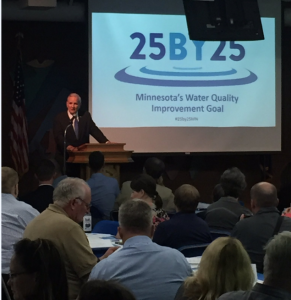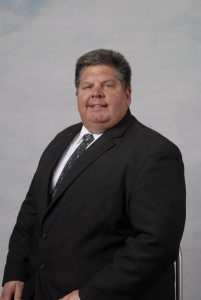
Polluted waters and systems in disrepair
Minnesota Gov. Mark Dayton took the next step in his quest to improve his state’s declining water quality last week when he kicked off the first of ten town halls designed to engage citizens on various water issues.

Minnesota Governor Mark Dayton, courtesy of Minnesota Board of Water and Soil Resources
The process started in February when Dayton announced his 25 by 25 initiative to improve Minnesota’s overall water quality 25 per cent by 2025. Without the initiative Minnesotan’s could only expect an eight per cent improvement by 2034 according to Dayton who said that isn’t acceptable.
Dayton’s process is inclusive and he’s inviting citizens, business interests, farmers and scientists to join a “new collaborative effort” on water quality.
“Good solutions come from broad participation,” Angie Becker Kudelka told Great Lakes Now. Becker Kudelka is a director for Minnesota’s Board of Water and Soil Resources.
Polluted waters, invasive species and systems in disrepair
That Dayton is spearheading a water quality initiative is proof that even an environment-focused state like Minnesota is not immune from 21st century pollution problems.
In the February launch of 25 by 25 Dayton in a release said, “Without an ambitious, achievable goal, the quality of our water will continue to deteriorate.”
He then ticked off a list of Minnesota’s problems:
- More than 40 percent of the state’s waters are listed as impaired or polluted.
- Aquatic invasive species have infested 500 lakes
- Water treatment plants and delivery systems are in disrepair and Minnesota needs $11 billion over the next 20 years for water infrastructure.
While Dayton has put all constituents on notice of the need to improve, not far beneath the surface is the governor’s relationship with agriculture.
Like Ohio and Michigan for Lake Erie, Minnesota has a nutrient runoff problem from farms that that has led to dreaded algae blooms. The blooms not only negatively impact water quality they hurt tourism.

Terraces, conservation tillage and conservation buffers, courtesy of Lynn Betts, USDA
In 2015 Dayton took polluting farmers to task telling them, “You have a right to operate your land for lawful purposes, but you don’t have the right to dump your runoff and create cesspools where the rest of Minnesotans want to enjoy it and where wildlife wants to enjoy it,”
At issue was a Dayton proposal that would mandate farmers to create buffer strips adjacent to waterways that prevent pollution from runoff. Many farmers don’t want the state mandating their land use and often refer to it as a “land grab.”
Dayton encouraged farmers to “look into their souls” and support the buffer strip proposal. Agriculture groups including the Minnesota Farm Bureau strongly opposed Dayton’s buffer strip plan.
Can attitudes change?
Fast forward two years and Dayton and farmers are trying to find common ground.
Hard decisions loom but the strained relationship between Dayton and farmers appears to have moderated.
Becker Kudelka told Great Lakes Now that “25 by 25 is not about imposing regulations” which farmers are wary of. “It’s about setting place-based goals depending on the interest and capacity of local governments and citizens.”
She emphasized that separate from the 2025 initiative, “ag has been bringing forth good ideas on water conservation and quality.”
Muted support
If Dayton was looking for support from farmers for his 25 by 25 program from the Minnesota Farm Bureau it is muted, at best.

Kevin Paap, Minnesota Farm Bureau Federation President
Bureau President Kevin Paap in a lengthy email response to a Great Lakes Now inquiry spoke about 2025 in neutral terms.
Paap said “conservation and water quality practices need to be based on realistic consideration of a variability of options including agronomic, economic impacts and proactive solutions.”
He said the bureau is encouraging its members to attend the town halls and “to share with their fellow Minnesotans and neighbors what they are doing on their own farms to help find solutions to address water quality.”
Paap said “every day farmers use best management practices to reduce or eliminate negative impacts on water and the environment” and it is incumbent on all Minnesotans to improve water quality.
The Water Board’s Becker Kudelka said the opening town hall in Rochester attracted approximately 300 attendees including “many farmers.”
The town halls continue until early October.
Becker Kudelka said “Gov. Dayton will use the information generated to help guide next steps – aligned with local needs and desires to improve the pace of progress.”




